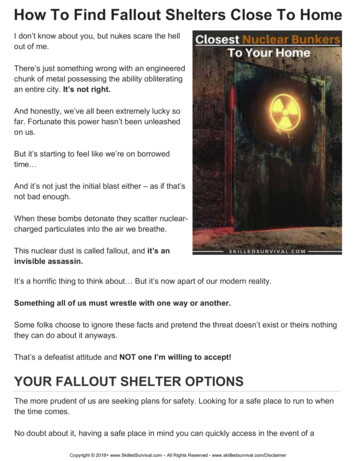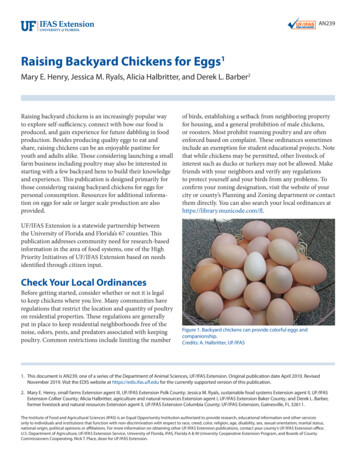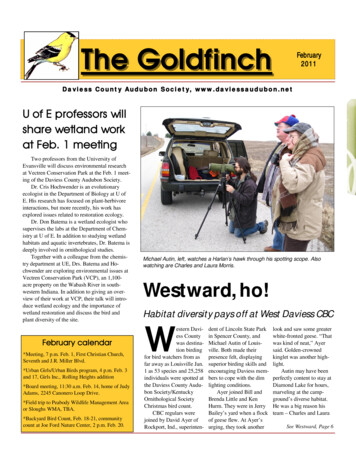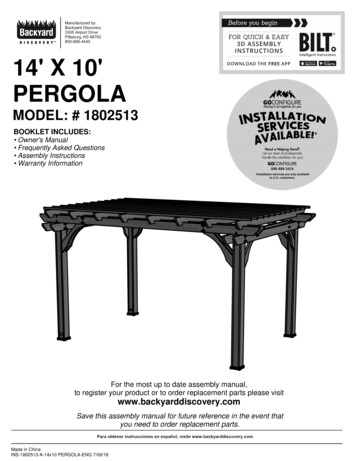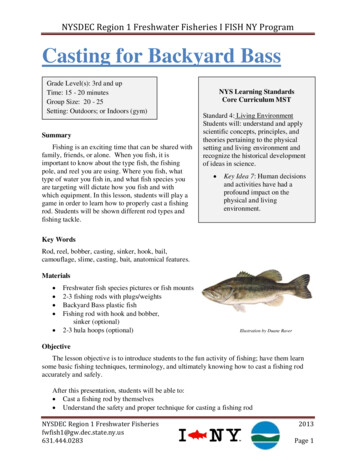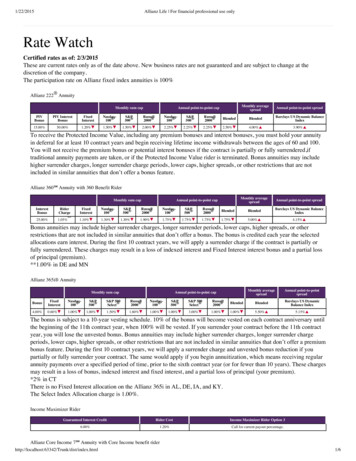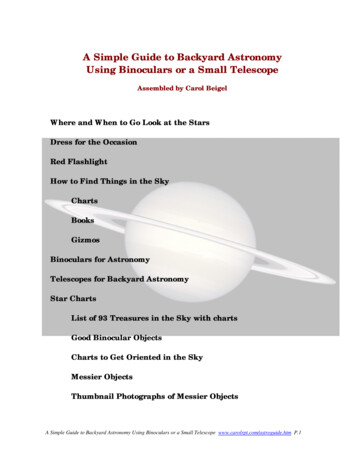
Transcription
A Simple Guide to Backyard AstronomyUsing Binoculars or a Small TelescopeAssembled by Carol BeigelWhere and When to Go Look at the StarsDress for the OccasionRed FlashlightHow to Find Things in the SkyChartsBooksGizmosBinoculars for AstronomyTelescopes for Backyard AstronomyStar ChartsList of 93 Treasures in the Sky with chartsGood Binocular ObjectsCharts to Get Oriented in the SkyMessier ObjectsThumbnail Photographs of Messier ObjectsA Simple Guide to Backyard Astronomy Using Binoculars or a Small Telescope www.carolrpt.com/astroguide.htm P.1
The Earth’s MoonMoon Map courtesy of Night Sky Magazine escope.com/nightskyA Simple Guide to Backyard Astronomy Using Binoculars or a Small Telescope www.carolrpt.com/astroguide.htm P.2
A Simple Guide to Backyard Astronomyusing Binoculars or a Small Telescopeassembled by Carol Beigel in the Summer of 2007The wonderment of the night sky is a passion that must be shared.Tracking the phases of the Moon, if only to plan how much light it will put intothe sky at night, and bookmarking the Clear Sky Clock, affectionately known asthe Cloud Clock become as common as breathing. The best observing nights fallabout a week after the Full Moon until a few days after the New Moon. However,don't wait for ideal and see what you can see every night no matter where youare. I offer this simple guide to anyone who wants to look upward and behold themagnificence of the night sky.Light pollution complicates observing the night sky if you live near a cityas the brightness of the sky will determine how much you will be able to see. Stargazing in the Washington D.C. area can be a wonderful experience in your ownbackyard or an incredibly fantastic experience if you are willing to drive 2 to 8hours to find a dark sky. For more information about curbing light pollution andsaving money at the same time, or to see a light pollution map, check outwww.starrynightlights.com/lpindex.htmlAll it takes to get started is a lawn chair and a pair of binoculars Thenyou will want to know where to look for beautiful things in the sky, and how toknow where you have pointed your optics Soon you will want something to holdthe binoculars steady, bigger binoculars, a more comfortable lounge chair,warmer clothes and something to keep the dew off your optics Then. well,Pandora's Box has opened, and you realize that aperture is everything, the cost ofmounting the optics and accessorizing them far exceeds the cost of the opticsthemselves, and you are starting to wonder how nice a gift you need to buy foryour spouse so that you can acquire a new piece of astro stuff.Where and When to Go to look at the StarsYour backyard is a good place to start Most local astronomy clubs have publicoutreach programs and advertise public viewing nights. Here is a list of localastronomy clubs in the Washington, D.C. area.Northern Virginia Astronomy Club (NOVAC) http://www.novac.com /A Simple Guide to Backyard Astronomy Using Binoculars or a Small Telescope www.carolrpt.com/astroguide.htm P.3
Howard Astronomical League (HAL) http://www.howardastro.org/Astronomical Society of Greenbelt http://www.greenbeltastro.org/University of Maryland, College Park, Public Astronomy tmlSouthern Maryland Astronomical Society (SMAS) http://www.smas.us./The finest website ever to check out the condition of the sky and locations forobserving is the Clear Sky Clock at http://www.cleardarksky.com/csk/.If you like camping, try attending a star party. Even if you don't own atelescope, star parties are fun to attend. People with big and small, homemadeor expensive telescopes are happy to show them off and let you take a look.They are great opportunities to see and try things before you buy. Some of theones I am familiar with are listed below, but there are wonderful star parties allover the country:The Mason-Dixon Star Party near Lancaster, PA usually in June or JulyStargaze in the Spring, and the No-Frills in the Fall at Tuckahoe State Park,MD sponsored by the Delmarva Stargazers clubAlmost Heaven Star party in August at the Mountain Institute on SpruceKnob, in West VirginiaThe Black Forest Star Party in Cherry Springs, PA in SeptemberDress for the Occasion!Always carry a jacket, hat and boots. The cosmos is a very, very coldplace, and it just sucks the warmth right out of you in the absence of sunlight.By day, the sun can be intense and burn your skin. A daytime, safari-style hatwith a broad brim and covers the back of your neck, though no fashionstatement, will help protect your face and neck from getting sunburned. Sunscreen, lip balm, moisturizing lotion and insect repellent are four things you donot want to be without in the middle of nowhere! Even in summer, mostastronomers battle cold temperatures at night! Changing the clothes next toyour skin at dusk, wearing wool socks and a hat that covers your ears will go along way to keeping you comfortable. Dew can be a problemand soaks through clothing, so water resistant outerwear is agood idea. A pair of gloves comes in handy when the dewfreezes on your equipment Wearing a hat will help keep yourfeet warm as fifty percent of your body heat escapes from thetop of your head. If you find that insulated boots are toobulky, try a pair of NEOS Overshoes. They fit over yourregular shoes, are very light weight, pack flat, and keep yourfeet warm and dry in water, mud, frost and /A Simple Guide to Backyard Astronomy Using Binoculars or a Small Telescope www.carolrpt.com/astroguide.htm P.4
Red FlashlightA flashlight that shines a red and not a white light is essential for navigatingyour way around in the dark on the observing field and reading the star charts.You can either cover a flashlight you have with rubylith, a red cellophane, orbuy one with a red LED bulb. Many clubs that sponsor public outreachprograms will be able to provide you with red cellophane for your flash lightwhen you arrive. I have come to prefer the kind of light you wear around yourhead so your hands are free. I really like my Petzl Tactikka Plus LEDHeadlamp I bought at REI. It has a red plastic cover that comes down over thewhite light and has 3 different levels of brightness andadjustment angles.WHY RED? Human eyes adapt to the dark by dilatingthe pupils and filling up with a chemical called visualpurple. A white light will cause immediate pain andtake your eyes another 30 minutes to readjust to thedark. A red light does not cause the visual purple todisappear or cause howling among theastrophotographers trying to take pictures.http://www.rei.com/product/709063How to Find Things in the Sky(and figure out what you are looking at!)There are many maps of the sky available. The selection isoverwhelming, so I will name my favorites. Photographs on the covers ofastronomy books and maps are spectacular, but you will NOT see those objectsin that beautifully illustrated way in a small telescope or with a pair ofbinoculars. You also will not be able to see the color shown in thesephotographs, so don't be disappointed at the outset!I own two bookshelves full of atlases and star charts, yet I cannot read them inthe dark with a red flashlight because the print is too small and/or they cram somany objects on the chart that you can't tell where they are. Many of the chartsincluded in this guide will be ones I created for myself and are specificallylimited to large, bright objects you can see with a small telescope or binoculars.Most of the objects can be seen to some degree with the naked eye in a dark sky,and many of them can be found using optics in the horribly light polluted skieshere in the Washington, D.C. area!A Simple Guide to Backyard Astronomy Using Binoculars or a Small Telescope www.carolrpt.com/astroguide.htm P.5
Most amateur astronomers use a combination of charts and gizmos to assistthem in finding celestial objects. There is even software that can be used on alaptop computer or Pocket PC that will guide you or a telescope to targets youchoose. Many new telescopes come with "Go-To" motors and software built intothem or something like Sky Commander can be used with large Dobsoniantelescopes to find and track objects in the sky.Planetarium SoftwarePlanetarium programs can be installed on a computer that will show you whatis available for viewing at anytime - both past and future. Most of my favoritesare available for free on the web.Hallo Northern Sky at: http://www.hnsky.org/software.htmWinStars 1.0 at artes du Ciel at www.stargazing.net/astropc/The Sky Tonight at www.skytonight.comPocket Sky runs on a pocket pc, but is not free, and can be purchased .aspThe What's Up Page on the Orion Telescope website Learning Center athttp://www.telescope.com/content/inthesky/Books and PlanispheresIf you were to buy only one book on astronomy, I would very highly recommendNIGHTWATCH, A Practical Guide to Viewing the Universe (Fourth Edition) writtenby Terence Dickinson ( 35). It is large enough to easily see the maps and charts in the dark,and is spiral bound. The photographs are astounding, but do remember they are probablystacked (composites of several photographs) and editedto display different wavelengths of light (color) thatsmall optics will not show you. Make sure you buy theFourth Edition as it just came out and has been revisedand expanded to use through 2018.A Simple Guide to Backyard Astronomy Using Binoculars or a Small Telescope www.carolrpt.com/astroguide.htm P.6
The Night Sky Planisphere published by David Chandler easy to use and has the leastdistortion of the constellation images. You can order one specifically for your latitude.Mine is the 30-40 degree one You rotate the wheel until it points to the day and time, and itshows you what is visible in the sky The Northern horizon is on the front side, and yousimply turn it over to see the Southern horizon.Both The Night Sky Planisphere and the Sky Atlas for Small Telescopes are published byDavid Chandler at www.davidchandler.com .Binocular Highlights: 99 Celestial Sites by George Seronik is available athttp://www.telescope.com. Sky and Telescope magazine's Pocket Sky Atlas by Roger Sinnottis one of the best of all time and is available at www.amazon.com. I keep my copy in the caralong with the Canon IS binoculars so I never leave home without them!Of course, my absolute favorite star charts are the ones I made for myself and included later inthis guide. They are designed with light pollution factored in so that only the brightest starsare shown on the charts. All 93 objects can be viewed using binoculars and/or a smalltelescope.A Simple Guide to Backyard Astronomy Using Binoculars or a Small Telescope www.carolrpt.com/astroguide.htm P.7
GIZMOSRed dot pointing devices mounted on binoculars , cameras or telescopes work very well. ARigel finder stands up a little higher and gives our face a little more room to aim the scope.You can aim the red dots at a specific point in the sky, then look through your scope. Ifeverything is lined up properly, the object you seek will be centered in the eye piece.A stand-alone "star finder" is the new Celestron Sky Scout. Not only does it have a lighteddisplay that is more or less possible to read in the dark, it can also talk to you if you use the earbuds that come along with it. It works by turning on its GPS and gets a lock on severalsatellites. Then you can point it to any area of the sky, day or night, and it will tell you whatobject you are looking at. You can even ask it to find something for you, and more of thelights will blink on the display the closer you get. I bought mine at Hands On Optics inDamascus, Maryland. It was really nice to go into the store and play with one before I boughtit! The unit does NOT like being close to metal objects, so it cannot be mounted to either abinocular or telescope mount.Meade has a similar product made of plastic called the mySKY, however the picture ismisleading because you will NOT see that beautiful galaxy in the window! I have not triedthis device.A Simple Guide to Backyard Astronomy Using Binoculars or a Small Telescope www.carolrpt.com/astroguide.htm P.8
Binoculars for AstronomyMany large deep sky objects look better in binoculars than in a telescope due to their largerfield of view. Although any pair will do, bigger binoculars gather more light than smallerones. Larger binoculars (15x70 and larger) should be mounted because it is hard to keep theimage steady whereas smaller models are easily hand held. There are also “image stabilizer”models that keep the target from moving.Because the pupils of the eyes dilate in the dark, binoculars for night use need larger exitpupils ratings than binoculars that will only be used in daylight.The exit pupil is simply theobjective (front /larger) lens diameter divided by the magnification (the smaller lenses next toyour eyes). A pair of 10x50 binoculars would have an exit pupil of 5; 10x30s have a 3; 8x56shave an exit pupil of 7. The larger the exit pupil, the brighter the target image will appear.In general, a larger field of view is better, but more magnification reduces field of view so theobserver needs to balance the factors. A telescope may have a view of only 1 degree, but manyobjects in the night sky are much larger and can only be seen in their entirety with binoculars.It is like the difference between viewing something the size of your fingertip versus the size ofyour hand at arm’s length. Another very important consideration is whether the binoculars willbe used with or without eyeglasses. For use with eyeglasses, more "eye relief" is needed. Longeye relief generally is at least 18 mm.(Drawing is from page 7 of the Edmund Sky Atlas, 1977)A Simple Guide to Backyard Astronomy Using Binoculars or a Small Telescope www.carolrpt.com/astroguide.htm P.9
There are two types of prisms used in binoculars: porro and roof. Porro prism binoculars costless. "BaK-4" (barium crown) glass is better quality than "BK-7" although the latter is notnecessarily bad. Coatings are used to focus the different wavelengths of light to a singlepoint to minimize color aberrations and halo effects. "Fully multi-coated" is best. Roofprism binoculars are better if they are also "phase coated".The Canon 10x30 IS (image stabilized) are my very favorite pair of binoculars. They areextremely light weight, and are the only handheld pair I use. They have a similar field of viewand brightness as regular 10x50s.The older Celestron Giants 20x80s were made with Japanese optics are the very best largebinoculars I have ever used. Although they are no longer made (original price was 400) usedpairs may become available. I fasten them to a parallelogram mount attached to a surveyor'stripod. On a dark sky, I can see nebulas very well - especially using only one nebulafilter fastened to one eyepiece. The current models with the same name are madedifferently and I cannot speak for their quality.This photo shows the Steady Viewmount and a red dot findermounted above the binoculars.A Simple Guide to Backyard Astronomy Using Binoculars or a Small Telescope www.carolrpt.com/astroguide.htm P.10
One of my favorite binocular mounts is the Couch Potato Telescope Chair. Itis made to handle mounting of small and medium sizedbinoculars up to 15x70 lightweight models. The entireassembly folds flat and easily fits into a car. It offers a 360degree rotation and good height adjustments. You can buy italready assembled, or buy it in kit form, or just buy the plansand make it yourself. The chair is made by Sim Picheloup inHouston, Texas. His website is:http://www.geocities.com/lwraif/SimP/Telescopes for Back Yard AstronomyThe best telescope is the one you use all the time. The telescope tube is theleast expensive item of the set-up once you consider eye pieces and mounting thething. Bigger and heavier is always better, but as you get older, weight willbecome more of a consideration than money. Depending on the construction of thetelescope, the image you see is usually upside down, and/or reversed left to right.A roof prism, although not necessary, will correct the position of the image. Aspotting scope gives you an image that is realistically oriented.There is an extensive selection of telescopes available in every conceivableprice range - reflectors, refractors, Dobsonians, Schmidt-Cassegrains, andMaksutovs. They all do different things and it all comes down to personalpreference and what you want to look at. You can even buy telescopes for only afew hundred dollars that have GOTO computers attached to them that will pointthemselves to whatever you want to look at in the sky. There are endless focallength specifications and eyepieces. Many decisions and trade-offs need to bebalanced in selecting a telescope as no one model meets all needs. Since I have hadaccess to many of them, I will list my favorite small telescopes as follows.The AstroScan from Edmund Scientific is the nearly indestructible telescope Ipurchased for my grandchildren. There is a good reviewof it at http://www.dansdata.com/astroscan.htm Mine isthe 199 version purchased online atwww.scientificsonline.com . It also comes with TheEdmund Sky Guide, a great little book to help you findthings in the sky, 2 eye pieces, and a finder attachmentthat works surprisingly well. It is lightweight and easilyfits in your lap, can sit on a table, or can be mounted on atripod.A Simple Guide to Backyard Astronomy Using Binoculars or a Small Telescope www.carolrpt.com/astroguide.htm P.11
The Yukon 6x100x100 Spotting Scope is very lightweight and versatile. It has built in zoom and theeyepiece can be easily rotated to different angles. Imount mine on a Carl Zeiss tripod. Both thescope and the tripod are in the 350 price range.Don't waste your money on anything less than aCarl Zeiss tripod!!! The website for the spottingscope is:http://www.yukonamericas.com/index.aspThe Celestron NexStar 4SE has high-quality Maksutov-Cassegrain opticswith Celestron's premium StarBright XLT coatings. It weighs 21 lbs including thetripod, is ultra portable and features a precision optical system with 1,325 mmfocal length (f/13) with a 105 mm (4-inch) mirror. This means it has a muchnarrower field of view than the above telescopes, but can see much fainter objectsin light polluted skies. It gives very good detail on the planets. It is alsocompletely computer-controlled (GoTo) and sets up in minutes. The database has40,000 objects. The first time I set up mine, I simply leveled the included tripod,adjusted the included red dot finder, pointed it to one bright object in the sky(Jupiter) and told it I was near Washington, D.C. It could find anything! It comeswith everything included that you need, and costs about 600.A Simple Guide to Backyard Astronomy Using Binoculars or a Small Telescope www.carolrpt.com/astroguide.htm P.12
The Coronado Personal Solar Telescope (PST) is the specialized little telescopethat has only one purpose - viewing the sun! NEVER, NEVER point any otheroptics directly at the sun without special filters!!! You will fry your eyes and youroptics! You can see solar storms on the surface of the sun which appear as blacksunspots when viewed head-on, or prominences, pictured below, when viewed at anangle. Sunspot activity is indicative of solar flare activity that causes the NorthernLights (Aurora Borealis). You can see predictions of aurora activity at:www.spaceweather.comLOMO 6" Maksutov Telescope. This is a short tube telescope with Russianoptics mounted to a fork mount on a heavy duty tripod. The wedge attached to thetripod enables the scope to "track", follow the rotation of the earth, when a small,9-volt battery operated servo motor is connected. This way the object in focus doesnot move out of view. Both the telescope and fork mount are made of steel.Because this set-up is very heavy I think twice before taking it anywhere.However, it has extremely sharp images and doesn't move in a strong wind! Thetent in the picture is a Kendrick observing tent. Kendrick also makes very gooddew zapper equipment. http://www.kendrickastro.com/astro.html The telescopetube looks longer in this photo because the dew shield is attached to the end.A Simple Guide to Backyard Astronomy Using Binoculars or a Small Telescope www.carolrpt.com/astroguide.htm P.13
Star ChartsMost star charts I have seen are cluttered with too many objects in a smallspace for me to be able to read in the dark with a red flashlight, so I made my owncharts using the Deep Space Astro Card software. The darker the sky, the moreobjects you will be able to see. You know when you are looking at a dark sky whenthe clouds appear black instead of white! Of course, the bigger the telescope themore detail you can see!The planets always travel the same path through the sky, called the Ecliptic. Theconstellations located along this path are known as the Zodiac. You can alwayscheck the almanac data in the newspaper to find which planets are visible andwhen. While stars focus to a point of light, planets focus to a solid object. Venuscan only be seen in the morning and evening, and Jupiter and Saturn can be seenduring the night as well as evening and morning depending upon where they are intheir orbits around the sun. Often, these very bright objects are miscalled theMorning or Evening Stars. Mars is visible only every 2 years and looks red. Youcan tell if you are looking at Jupiter because you can usually see at least 3 littlemoons near it. Saturn, with its rings, is the most impressive object in the sky nextto the moon!Only two double stars on are included on this list of objects, but the sky is full ofthem. Two easy ones to see with a small telescope are Mizar in the handle BigDipper and Albireo in the constellation Cygnus. My charts contain OpenClusters, Globular Clusters, Nebulas and Galaxies. Because galaxies are sodiffuse they are hard to see in light polluted skies. You need a larger telescope tosee most of them, however, the closest one, the Andromeda Galaxy, is best viewedwith binoculars. Galaxies can only be seen when looking out of the plane of ourown Milky Way Galaxy which appears as a narrow, bright celestial cloud spreadacross the sky. The Open Clusters will also be best viewed in binoculars. Globularclusters and nebulas will appear as "faint fuzzies" in the sky.List of 93 Treasured Objects in the SkyThis a list of 93 things you can see in the sky with a small telescope or pair ofbinoculars and 15 star charts to help you find them. The moon, planets, andcomets are NOT included because they are in different places each night. Thechart also includes a map key to assist you in finding these treasures. There is acolumn that lists each object’s magnitude - the lower the number the brighter theobject. Under light -polluted skies, or nights when the moonlight is bright, youmay only be able to see Mag 4 or less. The right ascension (RA ) is when an objectrises in the East with smaller numbers rising earlier. The Declination shows thedegrees the object is located North ( ) to South (-) of the celestial equator. Someobjects are best viewed in binoculars because they are so large.A Simple Guide to Backyard Astronomy Using Binoculars or a Small Telescope www.carolrpt.com/astroguide.htm P.14
Good Binocular Objects - These objects are included in my list of 93.NebulasOrion Nebula, M42Nebulas in Sagittarius, The Lagoon (M8), the Trifid (M20), the Swan (M17),Eagle (M16)The North American Nebula, NGC 7000 in CygnusThe Dumbell Nebula (M27) in VulpeculaThe Helix Nebula, NGC 7293 near AquariusOpen Star ClustersThe Peiades, M45The Hyades in TaurusThe Alpha Persei Group in PerseusThe Double Cluster in PerseusThe Coma Cluster in Coma BerenicesThe Beehive (Praesepe, M44) in CancerM6 and M7 above the tail of ScorpiusGlobular Clusters (look like fuzzy balls in binoculars as do comets)M13 and M92 in HerculesM22 in SagittariusOmega Centauri in Centaurus - only visible here in March and AprilGalaxiesThe Andromeda Galaxy, M31 - look between Cassiopeia and PegasusThe Triangulum Galaxy, M33Star ChainsKemble's Cascade in Camelopardus (between the North Star and the DoubleCluster in Perseus)Messier ChartsCharles Messier (1730-1817) was a French astronomer, and along with hisfriend, Pierre Mechain, compiled a list of 103 "faint fuzzies" they observed withsmall telescopes over the skies of Paris. Comet hunting was a very popularpastime back then, and since comets also appear as "faint fuzzies" in the sky,Messier compiled this list so they would not be mistaken for comets. Many of theseobjects are included in the 93 Objects Charts and Maps.Messier Object Thumbnail PhotographsThese are extremely beautiful photos; probably taken by the Hubble andothers who know how to do this. Astrophotography is a Pandora's Box all unto itsown. You will NOT be able to see these beautiful colors through a small telescope,however using a Nebula filter, you will be able to see some nebulosity as green.A Simple Guide to Backyard Astronomy Using Binoculars or a Small Telescope www.carolrpt.com/astroguide.htm P.15
This chart from p.7 of the Edmund Sky Guide can help you get oriented. to the skyfrom just about anywhere in the Northern Hemisphere. The charts that followshowing the sky through the seasons were distributed by Celestron at theirwebsite www.celestron.comA Simple Guide to Backyard Astronomy Using Binoculars or a Small Telescope www.carolrpt.com/astroguide.htm P.16
CB93 Best Objects in the Sky for Small Telescopes and Binoculars sorted by ConstellationObject IdNGC 224NGC 7089NGC 2099NGC 1960NGC 1912NGC 1502NGC 457NGC 581Stock 2NGC 2287NGC 2632NGC 2682NGC 4254NGC 5024Mel 111NGC 4192NGC 4826NGC 4501NGC 4736NGC 5272NGC 5055NGC 7092NGC 7000NGC 6913NGC 2168NGC 6205NGC 6341NGC 4590NGC 5236NGC 2548NGC 3351NGC 3368Other IdM31 - Andromeda GalaxyM2M37 - Auriga Salt-and-Pepper ClusterM36 - Pinwheel ClusterM38 - Starfish ClusterKemble's CascadeDragonfly ClusterM103M41- Little BeehiveM44 - Praesepe, Beehive ClusterM67- King CobraM99 - Coma PinWheel GalaxyM53Berenice's HairM98M64 - Black-Eye GalaxyM88 - Markarian's ChainM94 - Croc's EyeM3M63 - Sunflower GalaxyM39North American NebulaM29 - Cooling TowerM35M13 - Great Hercules ClusterM92M68M83 - Southern PinwheelM48M95M96Page 1 of 3 sorted by xGxGxGbGxOCNbOCOCGbGbGbGxOCGxGxR.A.00 42 42.021 33 30.005 52 18.005 36 18.005 28 42.004 07 48.001 19 30.001 33 24.002 15 00.006 46 00.008 40 00.008 50 48.012 18 48.013 12 54.012 25 00.012 13 48.012 56 42.012 32 00.012 50 54.013 42 12.013 15 48.021 32 12.021 01 48.020 23 54.006 08 12.016 41 42.017 17 06.012 39 30.013 37 00.008 13 42.010 44 00.010 46 48.0Decl. 41 16 00.0-00 49 00.0 32 33 00.0 34 08 00.0 35 51 00.0 62 20 00.0 58 17 00.0 60 39 00.0 59 16 00.0-20 45 00.0 19 40 00.0 11 49 00.0 14 25 00.0 18 10 00.0 26 00 00.0 14 54 00.0 21 41 00.0 14 25 00.0 41 07 00.0 28 23 00.0 42 02 00.0 48 26 00.0 44 12 00.0 38 32 00.0 24 22 00.0 36 28 00.0 43 08 00.0-26 45 00.0-29 52 00.0-05 45 00.0 11 42 00.0 11 49 00.0Const Mag a7.50Hya5.80Leo9.70Leo9.30DescriptionCB93 Map 1 largest object in the skyCB93 Map 2CB93 Map 3CB93 Map 3CB93 Map 3CB93 Map 4CB93 Map 1CB93 Map 1 and 4CB93 Map 1CB93 Map 5CB93 Map 5CB93 Map 5CB93 Map 6CB93 Map 6CB93 Map 6CB93 Map 6CB93 Map 6CB93 Map 6CB93 Map 7 and 15CB93 Map 6CB93 Map 7 and 15CB93 Map 1 and 8CB93 Map 8CB93 Map 8CB93 Map 3CB93 Map 7 and 15CB93 Map 7 and 15CB93 Map 9CB93 Map 9CB93 Map 5CB93 Map 10CB93 Map 10
CB93 Best Objects in the Sky for Small Telescopes and Binoculars sorted by ConstellationObject IdNGC 3623NGC 3627NGC 6779NGC 6720NGC 2323NGC 2264NGC 6333NGC 6254NGC 6171NGC 6273NGC 6402NGC 6218NGC 6266NGC 1976NGC 7078NGC 1039NGC 869Mel 20NGC 2422NGC 2477NGC 2447NGC 6121NGC 6475NGC 6124NGC 6405Cr 316NGC 6093NGC 6705NGC 6694NGC 5904NGC 6611NGC 6523Other IdM65 - in the Leo TriplettM66 - in the Leo TriplettM56M57 - Ring NebulaM50 - Heart-Shaped ClusterChristmas Tree ClusterM9M10M107M19M14M12 - Gumball ClusterM62- Flickering GlobularM42 - Great Orion NebulaM15 - Great Pegasus ClusterM34 - Spiral ClusterDouble Cluster in PerseusCr 39M47OCL 720M93 - Butterfly ClusterM4 - Cat's EyeM7 - Scorpions TailDunlop 514M6 - Butterfly ClusterFalse CometM80M11 - Wild Duck ClusterM26M5M16 - Eagle NebulaM8 - Lagoon NebulaPage 2 of 3 sorted by ConstellationTypeGxGxGbPlOCC NGbGbGbGbGbGbGbC NGbOCOCOCOCOCOCGbOCOCOCOCGbOCOCGbC NC NR.A.11 18 54.011 20 12.019 16 36.018 53 36.007 02 30.006 41 00.017 19 12.016 57 06.016 32 30.017 02 36.017 37 36.016 47 12.017 01 12.005 35 18.021 30 00.002 42 06.002 19 06.003 22 00.007 36 36.007 52 12.007 44 30.016 23 36.017 53 54.016 25 18.017 40 18.016 55 30.016 17 00.018 51 06.018 45 12.015 18 36.018 18 48.018 03 42.0Decl. 13 05 00.0 13 00 00.0 30 11 00.0 33 02 00.0-08 23 00.0 09 54 00.0-18 31 00.0-04 06 00.0-13 03 00.0-26 16 00.0-03 15 00.0-01 57 00.0-30 07 00.0-05 23 00.0 12 10 00.0 42 47 00.0 57 08 00.0 49 00 00.0-14 29 00.0-38 32 00.0-23 51 00.0-26 32 00.0-34 48 00.0-40 39 00.0-32 15 00.0-40 50 00.0-22 59 00.0-06 16 00.0-09 24 00.0 02 05 00.0-13 47 00.0-24 23 00.0Const Mag 8.00Ser5.80Ser6.00Sgr5.00DescriptionCB93 Map 6 and 10CB93 Map 6 and 10CB93 Map 8CB93 Map 8CB93 Map 5CB93 Map 5CB93 Map 11 and 12CB93 Map 11CB93 Map 11CB93 Map 11 and 12CB93 Map 11CB93 Map 11CB93 Map 12CB93 Map 5CB93 Map 2CB93 Map 1CB93 Map 1
The best observing nights fall about a week after the Full Moon until a few days after the New Moon. However, . astronomy books and maps are spectacular, but you will NOT see those objects in that beautifully illustrated way in a small telescope or with a pair of binoculars.

